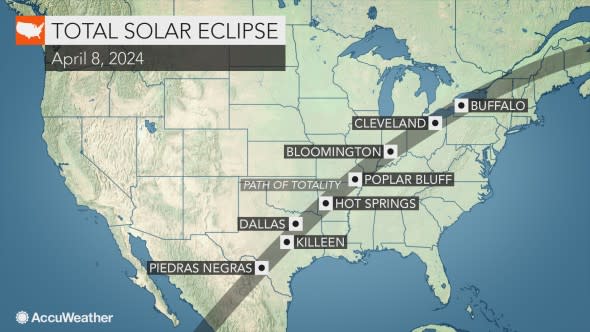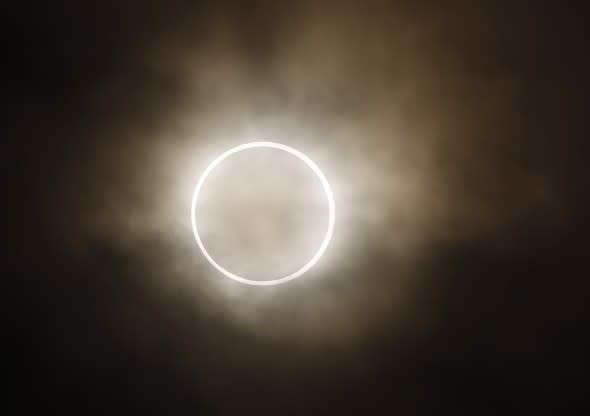2024 total solar eclipse may rival last year's Great American Eclipse
Tuesday marks the one-year anniversary of the Great American Eclipse, the most-viewed total solar eclipse in history.
Millions gathered along a narrow path from Oregon to South Carolina on Aug. 21, 2017, to see the moon pass directly between the Earth and the Sun, causing day to turn to night for a few short minutes.
Since the eclipse was visible from coast to coast and totality was limited to the United States, it became known as the Great American Eclipse.
While only a small area experienced a total eclipse, much of the rest of the United States, as well as parts of Canada and Mexico, were able to witness a partial solar eclipse.
This was the first total solar eclipse in the contiguous United States since the start of the social media era, with the one prior taking place in 1979.
Solar eclipse anniversary
AP Photo/Garret Fischer



First, at vero eos et accusamus et iusto odio dignissimos ducimus qui blanditiis praesentium et accusamus et iusto odio dignissimos ducimus qui voluptatum.
















(Photo/AccuWeather Meteorologist Brian Lada)

(AP Photo/Jeff Roberson)
Partial phases of the eclipse at Gateway Arch on Monday, Aug. 21, 2017, in St. Louis.

(AP Photo/Charlie Riedel)
The partial phase of the eclipse as seen from near Useful, Mo.

(Photo/AccuWeather Meteorologist Brian Lada)
Crescent-shaped shadows during the solar eclipse.

(Photo/MrsAgTeacher)
Crescent-shaped shadows in a colander in Burley, Idaho.

(AP Photo/Timothy D. Easley)
The diamond ring effect during the total eclipse on Aug. 21, 2017.

(AP Photo/John Minchillo)
Tyler Hanson watches the sun moments before the total eclipse in Nashville, Tenn.

(Photo/annperkinss)
The total solar eclipse as seen from Corvallis, Oregon.

(Image via Twitter/CAnnaIng)
Partial eclipse in Tampa, Florida.

(AP Photo/Seth Wenig)
A partial solar eclipse is seen near the Statue of Liberty.

(AP Photo/Wilfredo Lee)
Physics professor Bryan Armentrout focuses a telescope on Aug. 21, 2017.

(Photo/AccuWeather Meteorologist Becky DePodwin)
A view of the horizon during totality.

(AP Photo/Don Ryan)
Lee Cooper, from England, wears protective glasses to watch the solar eclipse.

(Image/NOAA/CIRA)
The shadow of the moon passing over the U.S. as seen from space.

(Photo/AccuWeather Meteorologist Brian Lada)
Traffic backed up for miles after the eclipse was over on Aug. 21, 2017.

It is estimated that 215 million Americans watched last year's solar eclipse. This includes the partial phases, as well as online viewers.
This makes the Great American Eclipse the most-observed and most-photographed eclipse in history, according to the Associated Press.
Small towns and remote areas located along the path of totality became crowded with eclipse viewers as people from all across the continent traveled to see the celestial alignment.
This influx of people was a boon for local economies. Many hotels and campgrounds from Oregon to South Carolina were completely booked months ahead of time with some people planning their trips more than a year in advance.
National parks were popular areas to view the eclipse with totality being visible from 21 different sites.
"The total solar eclipse last August brought visitors in record numbers to several parks," the National Park Service said.
People that could not travel to see last year's total solar eclipse, and those that missed out due to cloudy weather, may want to start looking ahead to the next one that will be visible from the U.S. in less than a decade.
On April 8, 2024, the moon will once again be seen passing in front of the sun in the skies over the U.S. with the path of totality stretching from Texas to Maine.
Major cities that will experience a total solar eclipse include Dallas, Indianapolis, Cleveland, and Buffalo and Niagara Falls, New York.
Portions of Mexico and eastern Canada will also experience a total solar eclipse while nearly the rest of North America and Central America experience a partial solar eclipse.
Those hoping to see this eclipse should plan their trips well ahead of time, including booking hotels and purchasing eclipse glasses from a verified manufacturer.

While all eyes will be focused on the total eclipse in the eastern U.S. in 2024, the western U.S. will experience a different type of eclipse seven months prior.
On Oct. 14, 2023, an annular solar eclipse will be visible from Oregon to Texas, as well as Central America and parts of South America.
During an annular solar eclipse, the moon is farther away from the Earth, so it is not quite large enough to completely block the sun.
Because of this, they are often referred to as ‘Ring of Fire' eclipses.

An annular eclipse appears at a waterfront park in Yokohama, near Tokyo, Monday, May 21, 2012. The annular eclipse, in which the moon passes in front of the sun leaving only a golden ring around its edges, was visible to wide areas across China, Japan and elsewhere in the region before moving across the Pacific to be seen in parts of the western United States. (AP Photo/Shuji Kajiyama)
Since the moon never completely blocks the sun, onlookers must use solar filters throughout the entire event, unlike a total eclipse of the sun when spectators can remove their solar filters during totality.
Looking at the sun without specially-made solar filters can lead to permanent eye damage.
There have been many cases of eye damage following the Great American Eclipse. One woman in her 20s burned holes in both of her retinas after looking at the sun several times without protective eyewear, resulting in a permanent blind spot in one of her eyes.
Following the close pair of eclipses in 2023 and 2024, the contiguous U.S. will not see another total solar eclipse until Aug. 12, 2045.
This eclipse will be visible across a similar area to that of 2017's eclipse; however, it will be significantly longer with totality lasting for more than six minutes.
Questions or comments? Email Brian Lada at Brian.Lada@accuweather.com and be sure to follow him on Twitter!
Follow @wxlada


